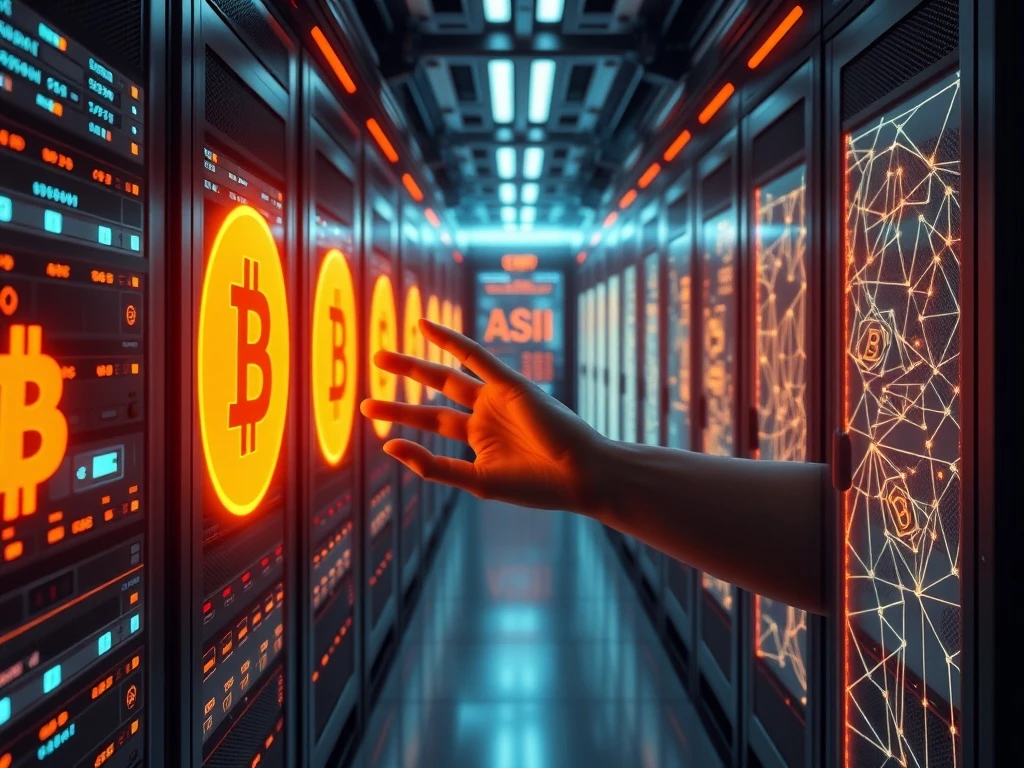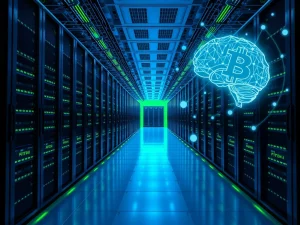Bitcoin Miners Unlocking Billions: The AI Computing Gold Rush

The landscape for Bitcoin miners has fundamentally changed. Many companies faced a critical juncture after the recent Bitcoin halving. This event dramatically reduced block rewards, directly impacting profitability. However, a significant new opportunity emerged: the booming demand for AI computing. Miners are now leveraging their existing infrastructure, turning challenges into substantial new revenue streams.
The Pivotal Shift for Bitcoin Miners
The 2024 Bitcoin halving significantly altered the industry. It cut block rewards to 3.125 BTC, effectively halving miners’ income. This change, combined with rising electricity costs and expensive equipment maintenance, made traditional mining less profitable. Competition also intensified. Consequently, many mining companies struggled to maintain profit margins. They began actively exploring other revenue sources.
Bitcoin mining relies on specialized devices called ASICs. However, mining companies already possess energy-dense data centers. They also have robust power infrastructure. As demand for AI compute skyrocketed, many miners saw an opening. They started repurposing or upgrading their facilities. This involved installing powerful GPUs to support AI training and inference workloads. This strategic move helped offset the halving’s impact. It also led to more profitable and stable revenue streams.
Understanding the AI Computing Demand
Artificial intelligence demands immense computing power. Training large language models requires vast resources. Powering autonomous systems and running enterprise AI tools also need significant compute. Tech companies are racing to secure high-performance infrastructure. Therefore, Bitcoin miners are stepping in. They leverage their existing energy-intensive data centers. They also upgrade these facilities with GPUs.
Many miners now offer AI cloud services. Some rent out spare capacity. This diversification generates steady, non-crypto income streams. It reduces reliance on volatile Bitcoin (BTC) revenues. For example, AI workloads and Bitcoin mining both demand massive energy. By planning for both, miners can lease excess capacity to AI firms. This is especially useful during crypto downturns. It transforms stranded power into a stable cash flow.
Core Scientific’s Remarkable $3.5 Billion AI Transformation
Core Scientific provides a strong example. This company showed how shifting to AI can revive a struggling crypto mining firm. Core Scientific faced severe financial difficulties. They filed for Chapter 11 bankruptcy in late 2022. Low Bitcoin prices and heavy debt caused this crisis. The company restructured and returned to the Nasdaq in early 2024.
In June 2024, Core Scientific signed a landmark contract. It was a 12-year, $3.5 billion agreement with CoreWeave. CoreWeave is a prominent AI cloud computing company. This deal allowed Core Scientific to use parts of its infrastructure. It now supports CoreWeave’s high-performance computing needs. The company moved beyond solely mining Bitcoin. It now also provides critical AI services. Core Scientific’s revenue in Q1 2025 fell to $79.5 million. This was down from $179.3 million the previous year. However, the AI strategy significantly boosted investor confidence. The company’s stock price rose after the CoreWeave deal announcement. This reflected strong market support for its new direction. By mid-2025, CoreWeave restarted talks to acquire Core Scientific. This followed an unsuccessful $1 billion offer from the previous year. This renewed interest highlights the company’s focus on AI. It cushioned the impact of Bitcoin’s halving. It also positioned Core Scientific as a key player in the growing AI computing industry.
Hut 8’s Strategic AI Integration for Crypto Mining
Hut 8 has also embraced AI. It serves as a secondary income source. The company continues to prioritize Bitcoin mining. This business model combines stability and growth potential. A five-year contract includes fixed payments. It also features a revenue-sharing component. This ensures steady income. It also offers opportunities for additional earnings based on customer success.
In September 2024, the company launched Highrise AI. This subsidiary offers GPU-as-a-Service. It utilizes over 1,000 Nvidia H100 chips. These are specialized hardware for training and running advanced AI models. This move marked Hut 8’s official entry into the high-performance computing (HPC) market. Despite its AI venture, Hut 8 remains dedicated to Bitcoin mining. In the first quarter of 2025, it mined 167 BTC. This was a decrease from 716 BTC in the same period of 2024. The 2024 Bitcoin halving largely caused this reduction. The company continues to invest in its mining infrastructure. Its significant Bitcoin reserve supports this. Hut 8 holds 10,273 BTC. This makes it the ninth-largest corporate Bitcoin holder worldwide. For Hut 8, AI serves as a complementary strategy. It diversifies revenue. Bitcoin mining remains the core of its long-term plan.
Hybrid Models: How Data Centers Drive Diversification
As Bitcoin mining profits shrink, hybrid models gain traction. These models combine mining with AI computing. Companies like Hive and Iren prove this strategy works. They grow AI revenue without abandoning their Bitcoin roots. They diversify income while optimizing existing infrastructure.
Hive Digital Technologies’ AI Expansion
Formerly known as Hive Blockchain, the company rebranded in mid-2023. This reflected its broader high-performance computing ambitions. Hive invested $30 million. This funded the deployment of Nvidia-powered GPU clusters. It marked a decisive pivot toward AI workloads. This investment quickly began to pay off. In fiscal 2025, Hive’s AI and HPC hosting revenue tripled. It reached $10.1 million, almost 9% of its total revenue. Hive has set an ambitious target. They aim for $100 million in AI revenue by 2026. This signals a strong commitment to expanding its hybrid model.
Iren (Iris Energy)’s Dual Approach
Australian mining firm Iren started its AI journey in early 2024. It began with just 248 GPUs. By mid-2025, it scaled up significantly. It now operates more than 4,300 units. The firm’s hybrid model already generates results. It mined 1,514 BTC in Q3 FY2025. It also pulled in $3.6 million from AI cloud services. To support this growth, Iren builds AI-focused data centers. These are located in Texas and British Columbia. Still, the company faces a challenge. A class-action lawsuit filed in October 2024 alleges it misled investors. It concerned the operational readiness of its Texas facility. This casts a shadow over its otherwise promising expansion.
Future-Proofing: Riot Platforms and MARA’s AI Vision
Some Bitcoin miners already earn revenue from AI. Others build foundations for future AI opportunities. Riot Platforms and MARA Holdings are leading companies. They are strategically planning for AI integration. They also maintain their focus on Bitcoin mining.
Riot Platforms’ Strategic Assessment
Riot Platforms explores AI possibilities. It started assessing the potential to convert 600 megawatts. This is at its Corsicana, Texas, facility. It could become high-performance computing (HPC) infrastructure. Riot has not yet secured significant AI contracts. However, its Corsicana site covers 355 acres. It has capacity to support up to 1 gigawatt of computing power. This gives it a decisive advantage. Financially, Riot remains robust in its primary business. It mined 1,530 BTC in Q1 2025. It also earned $142.9 million in mining revenue. The company also holds 19,225 BTC (as of July 17, 2025). This is one of the largest corporate Bitcoin reserves worldwide.
MARA Holdings’ Edge Computing Focus
MARA possesses the most extensive Bitcoin treasury. It holds 50,000 BTC among mining companies. This is second only to Strategy among public companies. Its AI strategy focuses on edge computing. This includes developing its MARA 2PIC700 immersion cooling system. This system handles intensive computing tasks. While MARA has the infrastructure ready, its AI efforts have not yet resulted in significant contracts or consistent revenue. For now, a move into AI remains a forward-looking strategy. It holds potential for future growth. Remember, Bitcoin mining relies on ASICs. However, AI needs GPUs like Nvidia’s H100s. Some miners are now retrofitting data centers with GPUs. This supports AI clients. It creates dual-purpose infrastructure. This balances both blockchain and AI demands.
An Outlier Case: Canaan’s Retreat from AI
Most Bitcoin miners explore AI. They aim to broaden income sources. Canaan, however, took a different approach. In July 2025, the company closed its AI chip division. It stepped away from the high-performance computing sector. This decision reflects a renewed focus. It prioritizes its primary expertise: designing application-specific integrated circuits (ASICs) for Bitcoin mining. Instead of pursuing the growing AI market, Canaan advances its mining hardware. This aims to maintain a competitive edge. Still, it holds only 2.1% of the global ASIC market. This is far behind leading competitors like Bitmain and MicroBT. By prioritizing mining-focused hardware, Canaan adopts a unique strategy. It also strengthens its presence in markets like North America. Its long-term success is yet to be determined.
Navigating the AI Market: Key Risks for Bitcoin Miners
As Bitcoin miners increasingly shift to AI, this transition offers opportunities. Yet, it also presents significant risks. Miners must carefully consider several factors. AI firms often face pressure to go green. Miners already using renewable energy can attract AI clients. This helps them meet sustainability targets through clean colocation deals.
- Infrastructure Costs vs. Returns: Moving from ASIC-based mining to GPU-based AI systems requires substantial initial investment. Miners must ensure potential long-term revenue outweighs these costs.
- Client Stability: AI clients, particularly startups, may lack consistent funding. They might also have limited long-term reliability. Miners should carefully evaluate clients. This avoids payment defaults or service interruptions.
- Power Supply Reliability: AI operations demand continuous, high-energy usage. Miners must secure stable, long-term power agreements. They must also monitor local grid capacity. This prevents outages or sudden price increases.
- Cooling and Thermal Management: AI chips, such as Nvidia H100s, produce significant heat. Inadequate cooling systems can lead to equipment failures. They can also reduce efficiency. Proper thermal management is crucial for AI computing.
- Regulatory Compliance: Hosting AI workloads involves complex regulations. These relate to data privacy, intellectual property, and international data hosting. Energy use, water consumption, and carbon emissions are also regulated. Miners must be prepared to navigate these rules.
- Market Competition: More miners are entering the AI colocation market. Consequently, pricing could decline. Early entrants should establish advantages. These include strategic locations, low energy costs, or large-scale operations.
- Resource Strain: Expanding into AI while maintaining mining operations may overstretch resources. This includes both financial and management capabilities.
The strategic pivot towards AI computing represents a transformative period for the crypto mining industry. While the Bitcoin halving presented challenges, it simultaneously spurred innovation and diversification. Companies are leveraging their unique infrastructure advantages. They are securing new, stable revenue streams. This evolution positions them not just as cryptocurrency validators, but as vital contributors to the broader technological advancement driven by artificial intelligence.









